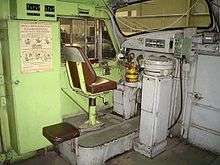South Australian Railways 900 class
The 900 class were a class of diesel locomotives built by Islington Railway Workshops for the South Australian Railways between 1951 and 1953.
| South Australian Railways 900 class | |||||||||||||||||||||||||||||||||||||||||||||||||
|---|---|---|---|---|---|---|---|---|---|---|---|---|---|---|---|---|---|---|---|---|---|---|---|---|---|---|---|---|---|---|---|---|---|---|---|---|---|---|---|---|---|---|---|---|---|---|---|---|---|
 900 Lady Norrie | |||||||||||||||||||||||||||||||||||||||||||||||||
| |||||||||||||||||||||||||||||||||||||||||||||||||
| |||||||||||||||||||||||||||||||||||||||||||||||||
| |||||||||||||||||||||||||||||||||||||||||||||||||
| |||||||||||||||||||||||||||||||||||||||||||||||||
History
The 900 class were the first main line diesels operated by the South Australian Railways. Ten were built at Islington Railway Workshops to replace steam locomotives on the heavily graded Mount Lofty Ranges. They operated both heavy freight trains and passenger services including The Overland. After the arrival of more powerful diesels, they were concentrated on the easier graded lines from Adelaide to Port Pirie and Peterborough.[1]
In March 1978 all were included in the transfer of the South Australian Railways to Australian National. Withdrawals commenced in May 1979[1] with the last two withdrawn on 18 June 1985 after operating a cement train from Angaston to Dry Creek.[2][3] Three have been preserved with the other seven scrapped.[4]
Preserved
Three units have been preserved:
- 900 Lady Norrie resides at the National Railway Museum, Port Adelaide[5]
- 907 resides in Tailem Bend under private ownership in derelict condition[6]
- 909 resides in Tailem Bend under private ownership being standard gauge converted[6]
References
- Oberg, Leon (1984). Locomotives of Australia 1850's - 1980's. Frenchs Forest: Reed Books. p. 190. ISBN 0 730100 05 7.
- "South Australia" Railway Digest August 1985 page 247
- Broad Gauge 900-class diesel locomotives Chris' Commonwealth Railway Pages
- 900 Class Railpage
- Lady Norrie National Railway Museum
- The Tailem Bend Train Graveyard Weekend Notes 10 February 2013
English Electric brochure TD120 https://www.flickr.com/photos/29903115@N06/6747430491

